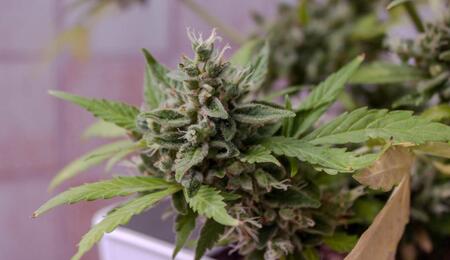Medical Marijuana Growers Ravage California Forest Habitat

Rush to profit caused forest clearing, stream diversions, careless pesticide/fertilizer use
Rush to profit caused forest clearing, stream diversions, careless pesticide/fertilizer use
SOURCE: The Sacramento Bee AUTHOR: Matt Weiser California's annual medical marijuana harvest is just about done, but this year brings a new revelation sweeping the nascent industry: The feel-good herb may not, in fact, be so good for the environment.From golden Sierra foothills to forested coastal mountains, an explosion of pseudo-legal medical marijuana farms has dramatically changed the state's landscape over the past two years. A rush to profit from patient demand for pot has resulted in irresponsible forest clearing, illegal stream diversions, and careless pesticide and fertilizer use that has polluted waterways and killed wildlife, state and local government officials said.The problem has become so big and so unregulated that the California Department of Fish and Game has resorted to aerial surveys to assess its scale. It has a new high-resolution, computer-controlled camera mounted in the belly of an aircraft to help pinpoint problem marijuana areas. In a recent flight over Nevada County, game warden Jerry Karnow was "astounded" at the increase in obvious marijuana grows visible from the air. They pop out as tightly clustered patches of vivid green plants in an otherwise sunbaked landscape, usually surrounded by tall fences.In the course of a 90-minute flight, the visible grows numbered in the hundreds, often carved out of mixed oak and pine forests on steep, erosion-prone hillsides. "I flew this last year and I'm seeing a whole bunch more than I did then," said Karnow, a warden in the region for 15 years. "This year it was unbelievable."Medical marijuana grows fall into a different category from illegal "trespass grows," which tend to be hidden on public land and maintained by criminal organizations. Pot grown for medicinal use is found on private land and legally permitted under state law.But the environmental problems they create are similar, in large part because the state's ability to regulate marijuana cultivation remains hazy. Though state law makes it legal to grow and use medical marijuana, it provides little guidance on how to regulate it. In addition, medicinal grows remain illegal under federal law, putting state and local agencies on uncertain ground when they attempt to set limits."The impacts of water withdrawal, herbicide and pesticide use, unpermitted grading -- all of these things in any other legal industry would be regulated. And we know how to regulate them," said Mark Lovelace, a Humboldt County supervisor who is grappling with the dilemma."In this case you can't bring them into compliance because the activity they are doing is fundamentally illegal according to the federal government."1996 law didn't set limitsCalifornia voters legalized marijuana for medicinal purposes in 1996 when they approved Proposition 215. The law allowed patients with a doctor's recommendation to possess and grow marijuana in limited quantities, but did not set clear limits. The Legislature tried to fix that loophole with Senate Bill 420, which took effect in 2004. It allowed Proposition 215 patients to cultivate no more than six mature or 12 immature plants. But the law was challenged in the state Supreme Court, which ruled in 2010 that the limit on plant numbers was invalid. Many growers took this as endorsement to cultivate all the marijuana they wanted. This may have triggered the explosion of medicinal grow sites across the state that is now prompting environmental concern."The belief is to get what you can while the growing's good, because it won't last forever," said Lovelace, who supports legal use of medicinal marijuana. "There are a lot of folks out there who just don't care about the environmental harm they are doing."In California, local governments have authority over land use. They issue permits to grade new roads, terrace hillsides for agriculture and build ponds. When the matter exceeds local authority, such as withdrawing water from a stream to irrigate a crop, they require a property owner to obtain permission from the appropriate state or federal agency.But their efforts to regulate medicinal marijuana cultivation have been largely unsuccessful.In 2008, the Mendocino County Board of Supervisors adopted an ordinance regulating marijuana cultivation. It was a groundbreaking attempt to legitimize the medical marijuana industry and address environmental concerns and nuisance complaints from neighbors. Under the ordinance, growers paid the county $50 per marijuana plant, each of which was then marked with a unique numbered "zip-tie" tag. The fee covered county regulatory costs, including inspections to ensure compliance with environmental standards. The grower industry welcomed the move and helped draft the rules.But in January, the county decided to gut the ordinance after the U.S. Department of Justice warned that it violated federal law by permitting growers to cultivate a federally controlled substance. The notice included a warning that local government officials might be prosecuted individually.This put a fast chill over other local government attempts to control the environmental effects of the rapidly growing industry.Stream illegally dammedMany marijuana growers strive to minimize environmental harm. Among other things, they want to create a product that is safe for humans to consume, free from harmful chemicals.Patricia Smith, a Nevada County grower, adheres to a voluntary industry program called "Clean Green Certification" which licenses marijuana that meets certain environmental standards. She also supports appropriate government regulation."I don't care if you're giving it away for free. Certain safety standards have to be met," said Smith, who chairs the county's chapter of Americans for Safe Access, a marijuana advocacy group. "I'll be the first to say not every person that is growing out there is an ethical person or a steward of the environment. I've seen some horrific things."In one recent case, game warden Karnow cited a Nevada County grower for illegally damming a stream that flows into Dry Creek, a tributary of the American River that supports salmon and steelhead. The grower excavated an 8-foot-tall earthen dam across the creek so he could pump water to a giant bladder, which then fed his cultivation site.The grower pleaded no contest on Aug. 27 to a misdemeanor charge of illegally diverting the stream."He didn't realize, apparently, the havoc he was wreaking by diverting the stream. And many of them don't," said Nevada County District Attorney Clifford Newell, whose office prosecuted the case. "They flaunt it being a natural herb. But many times there's nothing natural about the plants they grow."Part of the problem is that marijuana consumers are often blind to the methods used to grow the crop -- where the pot they are smoking was grown, or whether it was treated with pesticides."There's a huge population of people who eat organic food for breakfast and don't have any awareness at all of how their cannabis was cultivated or harvested," said Alison Sterling Nichols, a Humboldt County environmental consultant working with county leaders to reduce the environmental cost of marijuana growing. "They don't even think about what was put on it or what trees came down to plant it. There's just a complete disconnect."Pot grown in clearcutsThe consequences of that disconnect are especially acute in Humboldt and Mendocino counties, long the hotbed of marijuana cultivation in the state.The demand for medical marijuana has produced thousands of new clearcuts in North Coast forests. In each case, dozens of trees are cut, the land is graded for planting, and water is procured -- usually from the nearest stream -- to irrigate the crop.The region is struggling to restore endangered coho salmon in its coastal creeks. Millions of dollars have been spent on restoration projects, and logging and agriculture are under strict regulation. At the same time, marijuana cultivation has exploded."What I've seen is kind of similar to how logging used to take place back in the early days, before laws were really strong," said Scott Bauer, an environmental scientist and coho recovery coordinator at the Department of Fish and Game office in Eureka. "It's this gold-rush mentality right now, where everybody's out to get their piece of the action. So you see these grows have gotten substantially bigger over the past couple of years."One reason is that Proposition 215 allows medical marijuana users to form "collectives" to grow marijuana. A single grower can gather the doctor certificates from many patients and grow marijuana on their behalf. Instead of one person growing six mature plants, large grows have become common with hundreds of plants cultivated on behalf of many patients.Bauer said some growers fell trees, push them over the edge of a hillside, then bulldoze dirt on top of the trees to create flat planting areas. The bulldozed trees eventually rot, and in the next big storm, the piled soil cascades into the creek below, burying fish-spawning habitat.Most of these grows get water from the nearest stream, Bauer said. Normally this requires a stream alteration permit from Fish and Game. But many growers either don't know that or don't care, and set about engineering makeshift dams and ponds.Wildlife put at riskGrowers are tapping this water when wildlife need it most. The North Coast is known for its heavy rainfall. But that usually stops by June, and wildlife must survive through summer and fall on water that fills the streams from springs and seeps. This is also when marijuana plants demand the most water.Often water cannot be delivered by gravity flow to a cultivation site. So growers run diesel generators to power water pumps, which in turn fill storage tanks. The pumps may only run a few hours a day, but that can be enough to do serious harm."During that time, there is a dewatering process that will occur for hundreds of feet below the pump site," said Jackie Krug, a Humboldt County game warden. "You may not even realize the impacts you've just had, but you've just killed everything in that stretch of stream. "State officials are caught in the same legal bind that precludes local governments from regulating the industry. Fish and Game, for instance, is happy to consider issuing streambed alteration permits to marijuana growers, but only under a kind of "don't ask, don't tell" policy."If somebody were to call and say, 'I'm diverting water, I need a permit,' we're not going to ask what that diversion is for," said Bauer.Fish and Game is working to assess the industrywide water demand on the North Coast. It will start by examining a single watershed using aerial surveys to count marijuana grows. The goal is to understand how the industry is affecting the regional environment.Others hope consumer and grower education help address the problem."As long as we can't regulate it as a community, we have to rely on it being successfully self-regulated, which is rare in any industry," said Nichols. "It's just time to be less greedy and more responsible."(c)2012 The Sacramento Bee (Sacramento, Calif.)Visit The Sacramento Bee (Sacramento, Calif.) at www.sacbee.com
S
Soft Secrets



